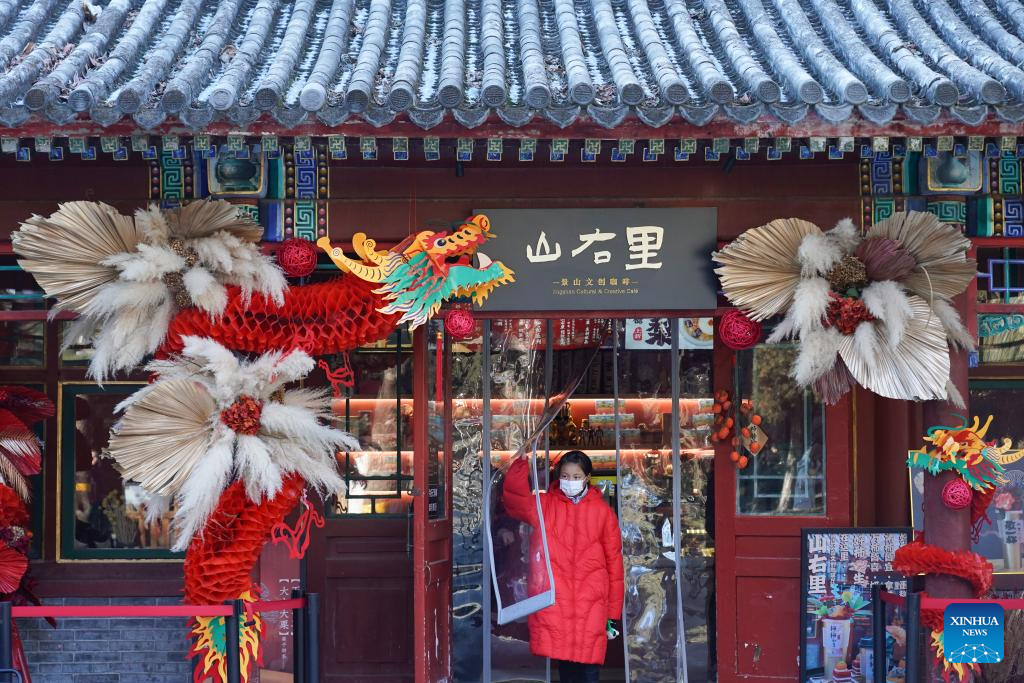
This photo taken on Jan. 23, 2024 shows festive decorations at a cultural and creative cafe in Jingshan park in Beijing, capital of China.
First created in the Yuan Dynasty (1271-1368), the Beijing Central Axis, or Zhongzhouxian, stretches 7.8 kilometers between the Yongding Gate in the south of the city and the Drum Tower and Bell Tower in the north. Gates, palaces, temples, squares and gardens of the old city are all linked up to the axis.
As the Spring Festival of the Year of the Dragon approaches, many festive elements with the theme of "dragon" have been spotted at the axis of Beijing, bringing citizens and tourists a journey of "dragon" culture through ancient and modern times. (Xinhua/Chen Zhonghao)
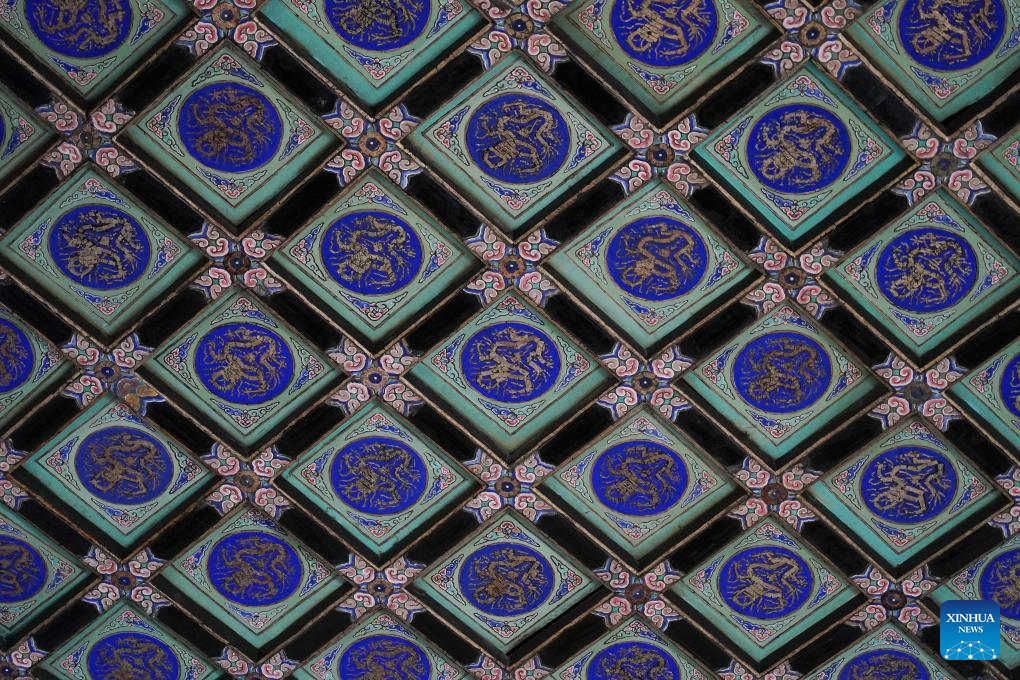
This photo taken on Jan. 21, 2024 shows dragon patterns painted on the ceiling of Biyong Hall of Guozijian in Beijing, capital of China. Guozijian is located in the buffer zone of the Beijing Central Axis conservation area.
First created in the Yuan Dynasty (1271-1368), the Beijing Central Axis, or Zhongzhouxian, stretches 7.8 kilometers between the Yongding Gate in the south of the city and the Drum Tower and Bell Tower in the north. Gates, palaces, temples, squares and gardens of the old city are all linked up to the axis.
As the Spring Festival of the Year of the Dragon approaches, many festive elements with the theme of "dragon" have been spotted at the axis of Beijing, bringing citizens and tourists a journey of "dragon" culture through ancient and modern times. (Xinhua/Chen Zhonghao)
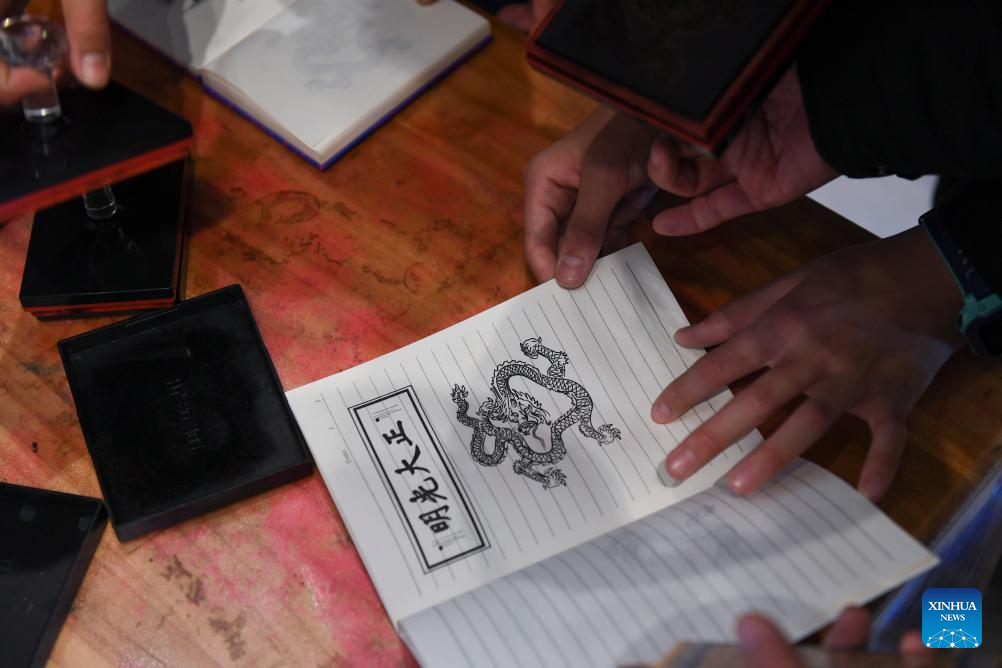
A visitor stamps a seal with the pattern of dragon at the Palace Museum in Beijing, capital of China, Jan. 28, 2024.
First created in the Yuan Dynasty (1271-1368), the Beijing Central Axis, or Zhongzhouxian, stretches 7.8 kilometers between the Yongding Gate in the south of the city and the Drum Tower and Bell Tower in the north. Gates, palaces, temples, squares and gardens of the old city are all linked up to the axis.
As the Spring Festival of the Year of the Dragon approaches, many festive elements with the theme of "dragon" have been spotted at the axis of Beijing, bringing citizens and tourists a journey of "dragon" culture through ancient and modern times. (Xinhua/Chen Zhonghao)
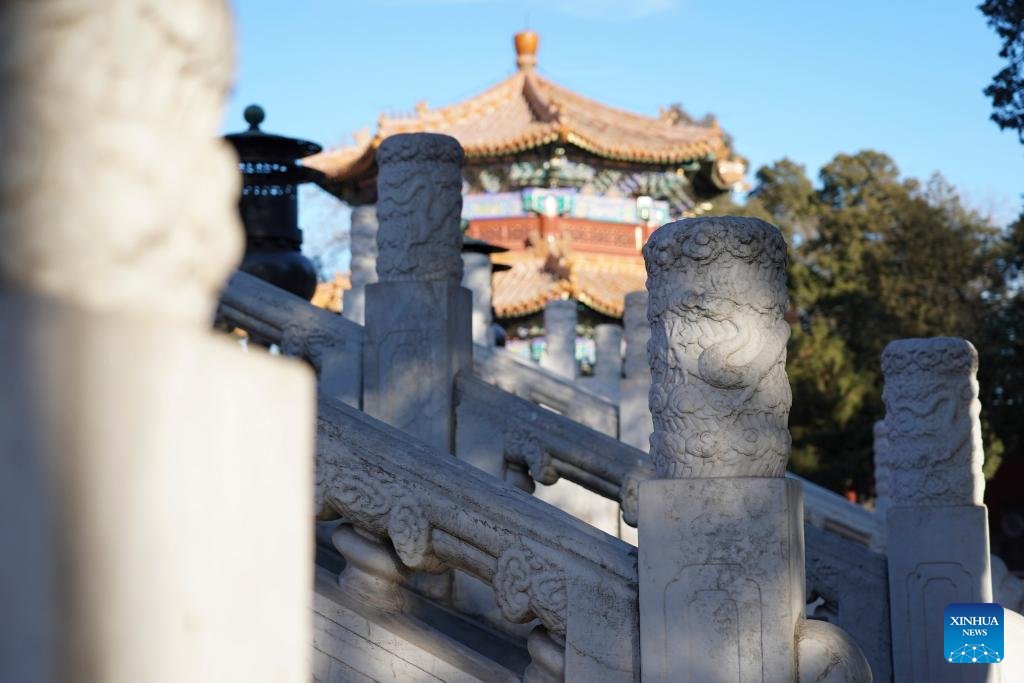
This photo taken on Jan. 23, 2024 shows dragon patterns carved on white marble railings of Shouhuang Hall in Jingshan park in Beijing, capital of China.
First created in the Yuan Dynasty (1271-1368), the Beijing Central Axis, or Zhongzhouxian, stretches 7.8 kilometers between the Yongding Gate in the south of the city and the Drum Tower and Bell Tower in the north. Gates, palaces, temples, squares and gardens of the old city are all linked up to the axis.
As the Spring Festival of the Year of the Dragon approaches, many festive elements with the theme of "dragon" have been spotted at the axis of Beijing, bringing citizens and tourists a journey of "dragon" culture through ancient and modern times. (Xinhua/Chen Zhonghao)
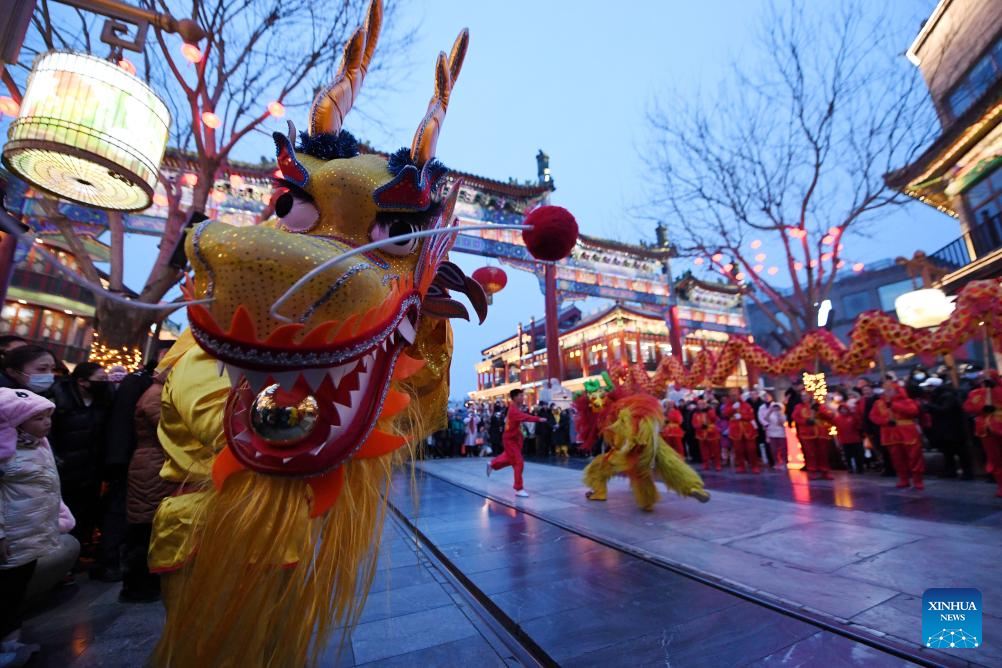
People watch dragon dance at the Qianmen Street in Beijing, capital of China, Feb. 2, 2024.
First created in the Yuan Dynasty (1271-1368), the Beijing Central Axis, or Zhongzhouxian, stretches 7.8 kilometers between the Yongding Gate in the south of the city and the Drum Tower and Bell Tower in the north. Gates, palaces, temples, squares and gardens of the old city are all linked up to the axis.
As the Spring Festival of the Year of the Dragon approaches, many festive elements with the theme of "dragon" have been spotted at the axis of Beijing, bringing citizens and tourists a journey of "dragon" culture through ancient and modern times. (Xinhua/Ju Huanzong)
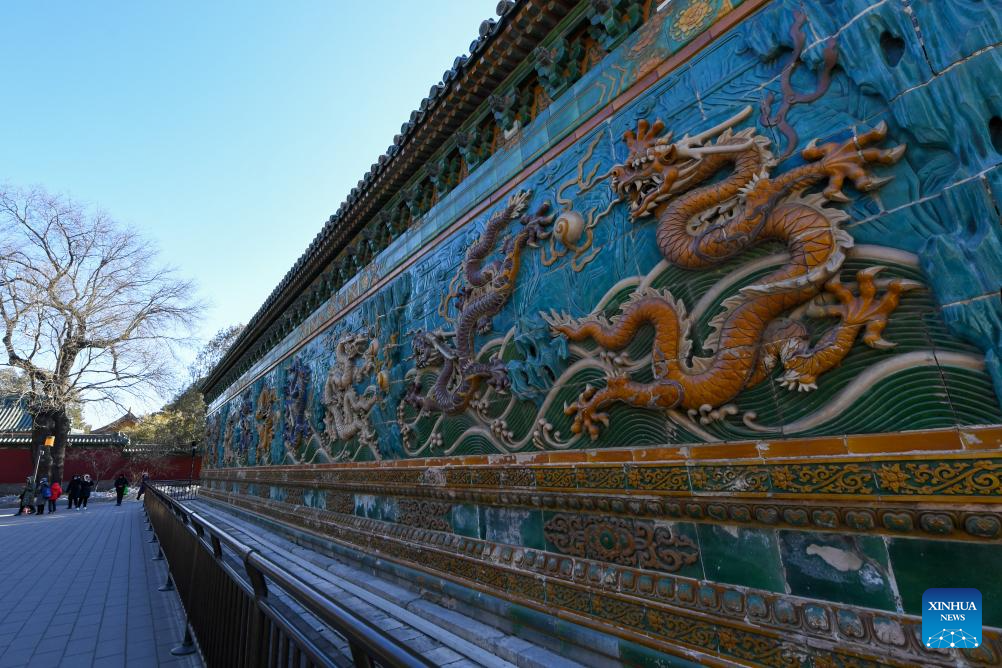
This photo taken on Jan. 24, 2024 shows the Nine-Dragon Wall at Beihai Park in Beijing, capital of China.
First created in the Yuan Dynasty (1271-1368), the Beijing Central Axis, or Zhongzhouxian, stretches 7.8 kilometers between the Yongding Gate in the south of the city and the Drum Tower and Bell Tower in the north. Gates, palaces, temples, squares and gardens of the old city are all linked up to the axis.
As the Spring Festival of the Year of the Dragon approaches, many festive elements with the theme of "dragon" have been spotted at the axis of Beijing, bringing citizens and tourists a journey of "dragon" culture through ancient and modern times. (Xinhua/Ju Huanzong)
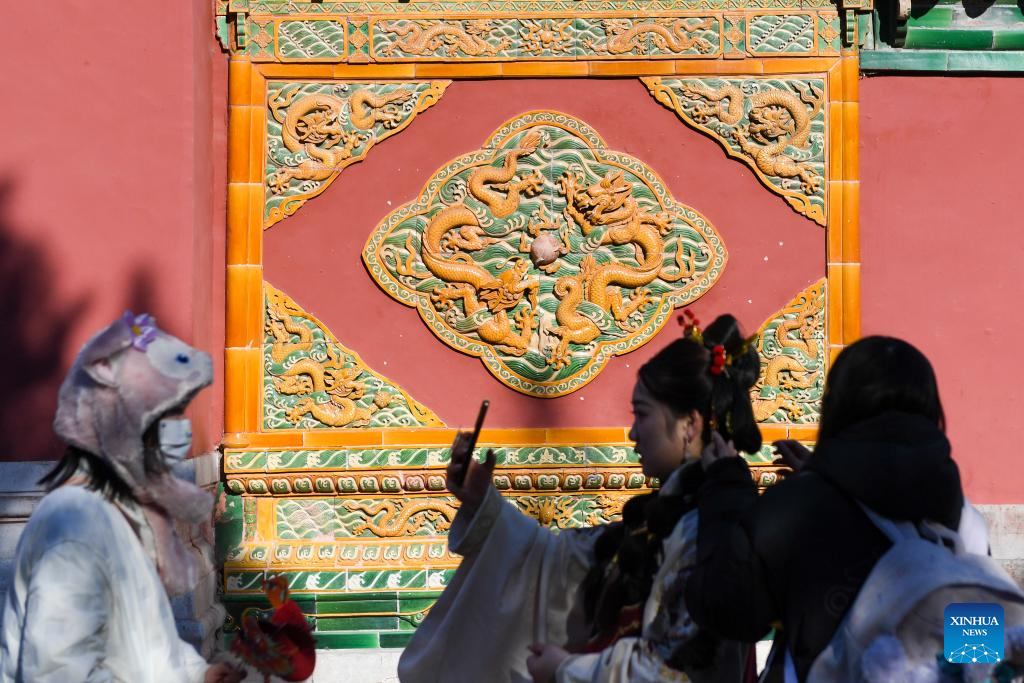
Tourists visit Beihai Park in Beijing, capital of China, Jan. 24, 2024.
First created in the Yuan Dynasty (1271-1368), the Beijing Central Axis, or Zhongzhouxian, stretches 7.8 kilometers between the Yongding Gate in the south of the city and the Drum Tower and Bell Tower in the north. Gates, palaces, temples, squares and gardens of the old city are all linked up to the axis.
As the Spring Festival of the Year of the Dragon approaches, many festive elements with the theme of "dragon" have been spotted at the axis of Beijing, bringing citizens and tourists a journey of "dragon" culture through ancient and modern times. (Xinhua/Ju Huanzong)
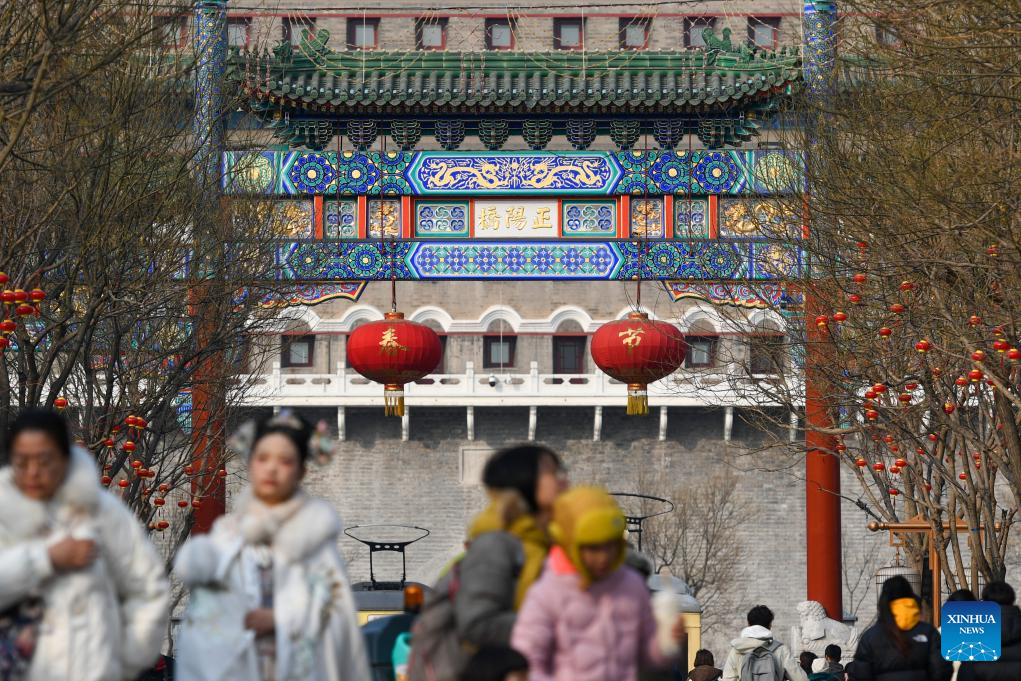
People visit the Qianmen Street in Beijing, capital of China, Feb. 5, 2024.
First created in the Yuan Dynasty (1271-1368), the Beijing Central Axis, or Zhongzhouxian, stretches 7.8 kilometers between the Yongding Gate in the south of the city and the Drum Tower and Bell Tower in the north. Gates, palaces, temples, squares and gardens of the old city are all linked up to the axis.
As the Spring Festival of the Year of the Dragon approaches, many festive elements with the theme of "dragon" have been spotted at the axis of Beijing, bringing citizens and tourists a journey of "dragon" culture through ancient and modern times. (Xinhua/Ju Huanzong)
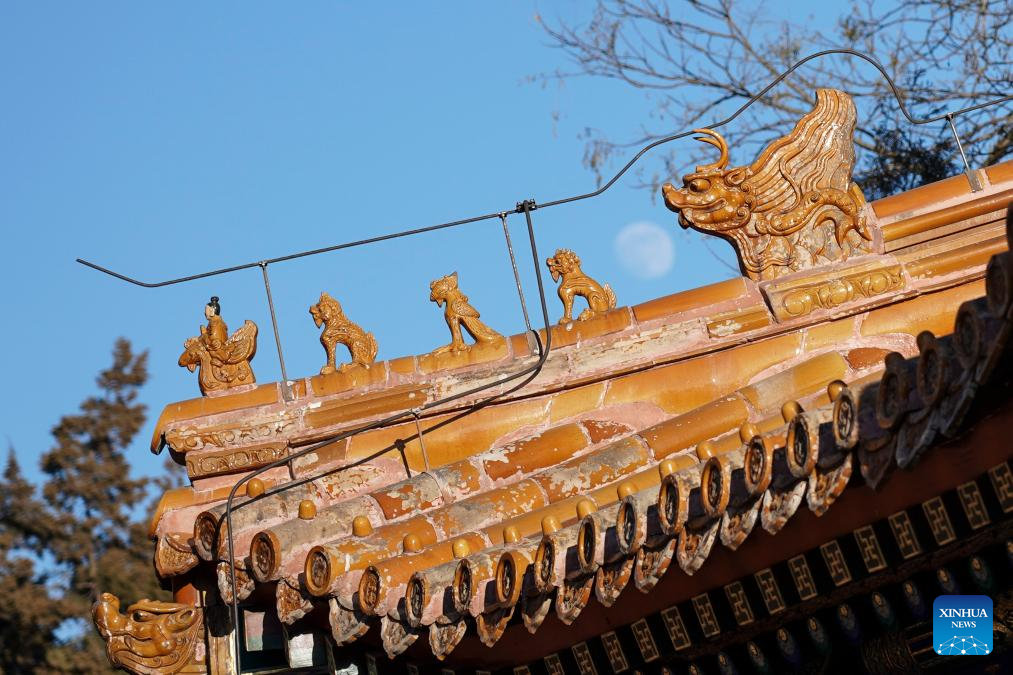
This photo taken on Jan. 23, 2024 shows ridge beasts on the roof of an ancient building in the courtyard of Shouhuang Hall in Jingshan park in Beijing, capital of China.
First created in the Yuan Dynasty (1271-1368), the Beijing Central Axis, or Zhongzhouxian, stretches 7.8 kilometers between the Yongding Gate in the south of the city and the Drum Tower and Bell Tower in the north. Gates, palaces, temples, squares and gardens of the old city are all linked up to the axis.
As the Spring Festival of the Year of the Dragon approaches, many festive elements with the theme of "dragon" have been spotted at the axis of Beijing, bringing citizens and tourists a journey of "dragon" culture through ancient and modern times. (Xinhua/Chen Zhonghao)
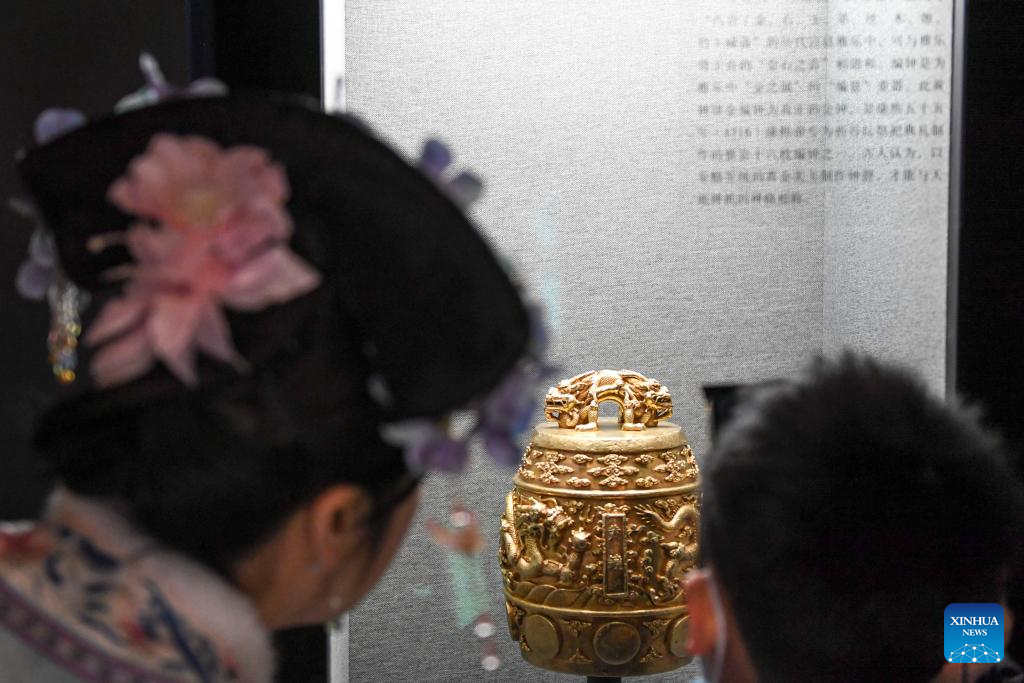
Visitors look at a chime bell in the Palace Museum in Beijing, capital of China, Jan. 28, 2024.
First created in the Yuan Dynasty (1271-1368), the Beijing Central Axis, or Zhongzhouxian, stretches 7.8 kilometers between the Yongding Gate in the south of the city and the Drum Tower and Bell Tower in the north. Gates, palaces, temples, squares and gardens of the old city are all linked up to the axis.
As the Spring Festival of the Year of the Dragon approaches, many festive elements with the theme of "dragon" have been spotted at the axis of Beijing, bringing citizens and tourists a journey of "dragon" culture through ancient and modern times. (Xinhua/Chen Zhonghao)
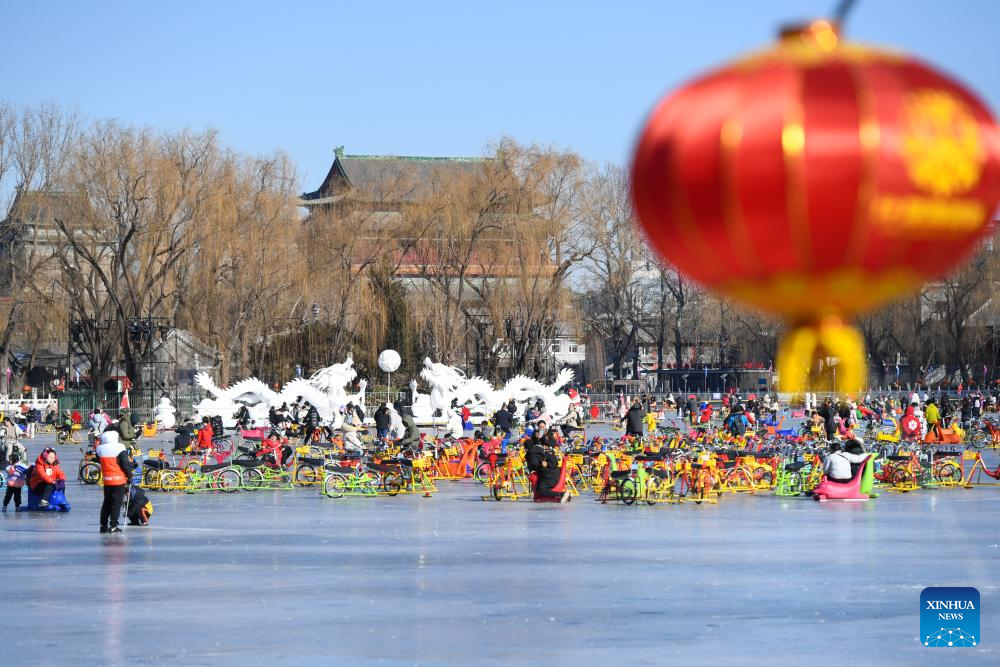
Dragon shaped decorations are seen on a seasonal outdoor ice rink on the frozen Shichahai lake in Beijing, capital of China, Jan. 24, 2024.
First created in the Yuan Dynasty (1271-1368), the Beijing Central Axis, or Zhongzhouxian, stretches 7.8 kilometers between the Yongding Gate in the south of the city and the Drum Tower and Bell Tower in the north. Gates, palaces, temples, squares and gardens of the old city are all linked up to the axis.
As the Spring Festival of the Year of the Dragon approaches, many festive elements with the theme of "dragon" have been spotted at the axis of Beijing, bringing citizens and tourists a journey of "dragon" culture through ancient and modern times. (Xinhua/Ju Huanzong)

Tourists from Malaysia pose for photos wearing dragon themed hats at the Temple of Heaven in Beijing, capital of China, Jan. 23, 2024.
First created in the Yuan Dynasty (1271-1368), the Beijing Central Axis, or Zhongzhouxian, stretches 7.8 kilometers between the Yongding Gate in the south of the city and the Drum Tower and Bell Tower in the north. Gates, palaces, temples, squares and gardens of the old city are all linked up to the axis.
As the Spring Festival of the Year of the Dragon approaches, many festive elements with the theme of "dragon" have been spotted at the axis of Beijing, bringing citizens and tourists a journey of "dragon" culture through ancient and modern times. (Xinhua/Ju Huanzong)
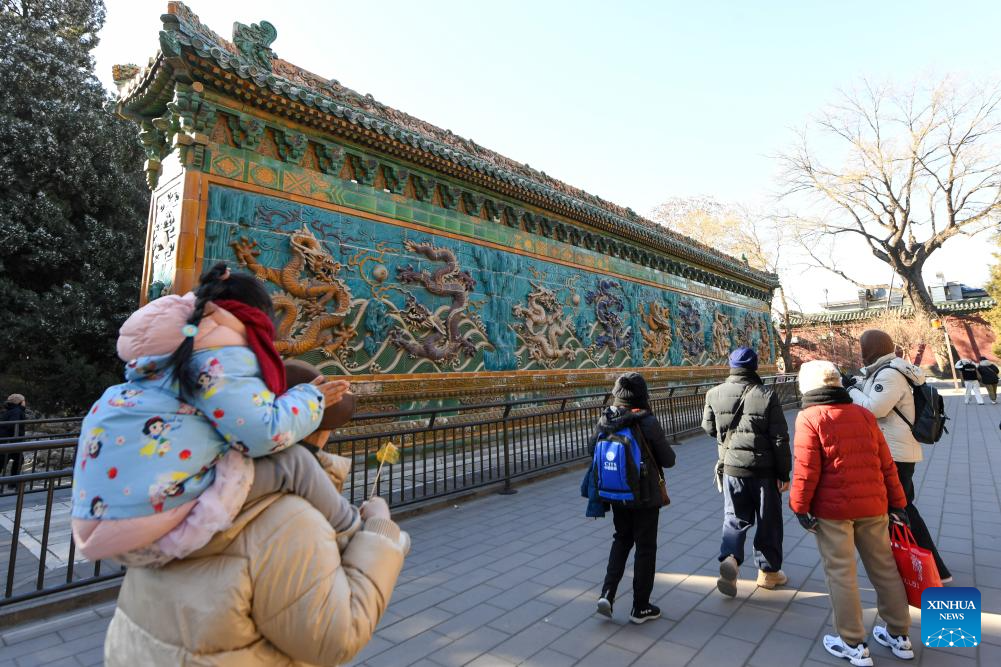
People visit the Nine-Dragon Wall at Beihai Park in Beijing, capital of China, Jan. 24, 2024.
First created in the Yuan Dynasty (1271-1368), the Beijing Central Axis, or Zhongzhouxian, stretches 7.8 kilometers between the Yongding Gate in the south of the city and the Drum Tower and Bell Tower in the north. Gates, palaces, temples, squares and gardens of the old city are all linked up to the axis.
As the Spring Festival of the Year of the Dragon approaches, many festive elements with the theme of "dragon" have been spotted at the axis of Beijing, bringing citizens and tourists a journey of "dragon" culture through ancient and modern times. (Xinhua/Ju Huanzong)
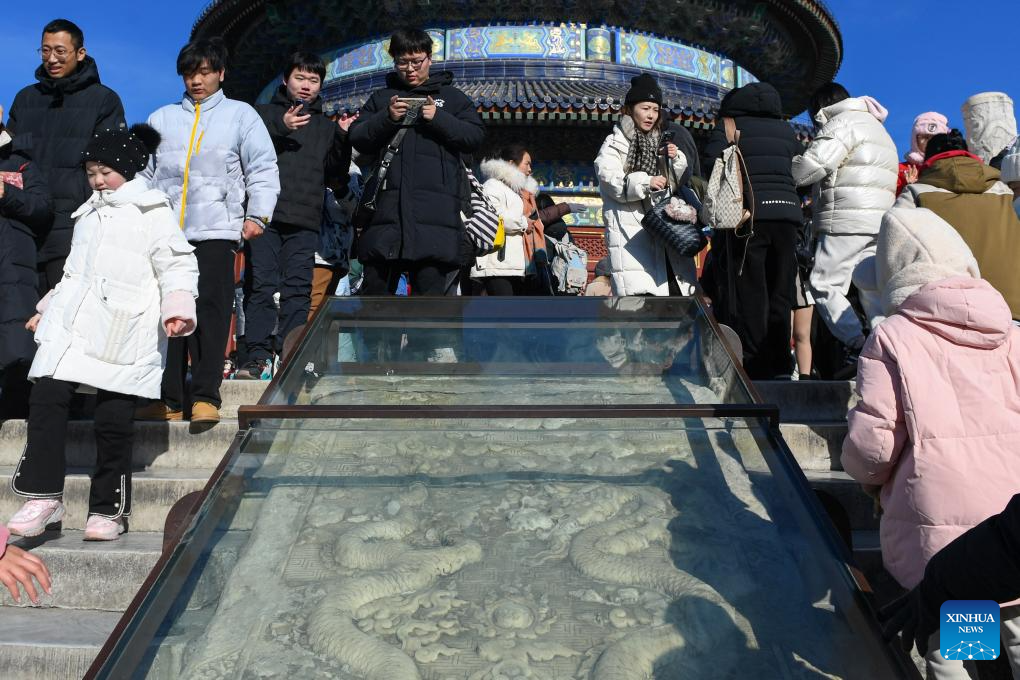
Tourists look at dragon themed stone carvings at the Temple of Heaven in Beijing, capital of China, Jan. 23, 2024.
First created in the Yuan Dynasty (1271-1368), the Beijing Central Axis, or Zhongzhouxian, stretches 7.8 kilometers between the Yongding Gate in the south of the city and the Drum Tower and Bell Tower in the north. Gates, palaces, temples, squares and gardens of the old city are all linked up to the axis.
As the Spring Festival of the Year of the Dragon approaches, many festive elements with the theme of "dragon" have been spotted at the axis of Beijing, bringing citizens and tourists a journey of "dragon" culture through ancient and modern times. (Xinhua/Ju Huanzong)
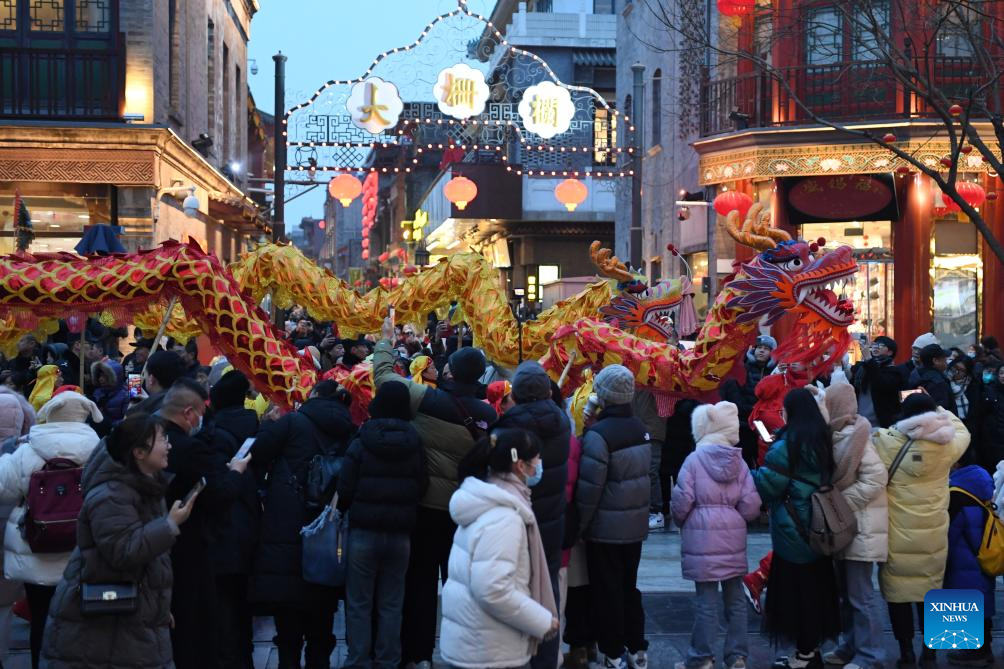
People watch dragon dance at the Qianmen Street in Beijing, capital of China, Feb. 2, 2024.
First created in the Yuan Dynasty (1271-1368), the Beijing Central Axis, or Zhongzhouxian, stretches 7.8 kilometers between the Yongding Gate in the south of the city and the Drum Tower and Bell Tower in the north. Gates, palaces, temples, squares and gardens of the old city are all linked up to the axis.
As the Spring Festival of the Year of the Dragon approaches, many festive elements with the theme of "dragon" have been spotted at the axis of Beijing, bringing citizens and tourists a journey of "dragon" culture through ancient and modern times. (Xinhua/Ju Huanzong)

